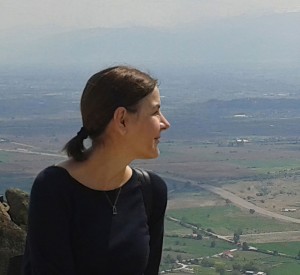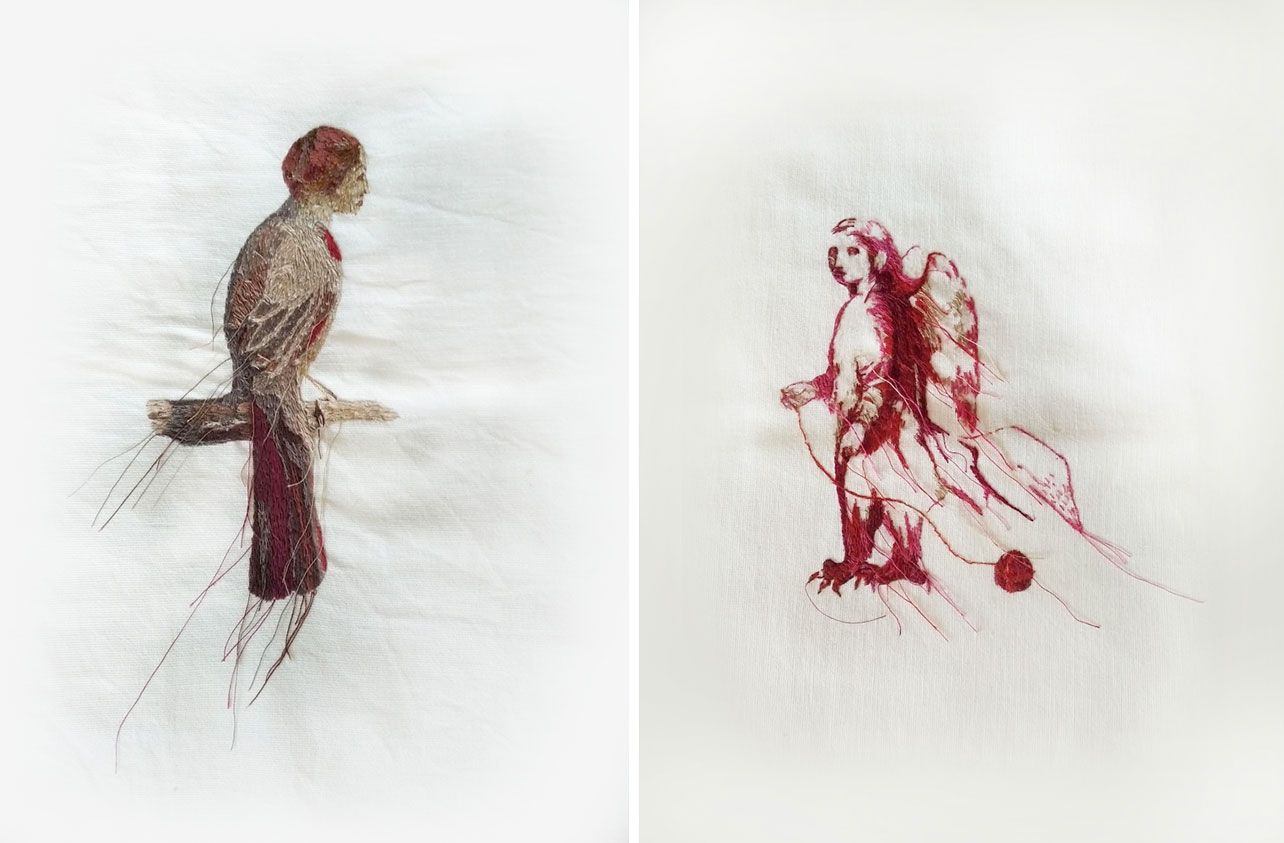IN THE STUDIO: Ifigenia Sdoukou
 The whole body of work by Iphigenia Sdoukou is characterized by two main elements: yarns and inks which are telling stories on the fabric and balancing between: history and tradition, contemporary minimalism, poetry and fairy tale. The artist retrieves elements from conscious and subconscious, life, sleep and death, and imprints them on her pillows and dresses with her own personal-fragile writing, while as a modern Ariadne she untangles the mystery of her own fiction in time, which is inextricably linked with her ancestral line. “Believing the bonds between sewing, weaving and writing are strong and tight, the echo of their relation resembles the beginnings of ancient storytelling” as she confesses in the her interview.
The whole body of work by Iphigenia Sdoukou is characterized by two main elements: yarns and inks which are telling stories on the fabric and balancing between: history and tradition, contemporary minimalism, poetry and fairy tale. The artist retrieves elements from conscious and subconscious, life, sleep and death, and imprints them on her pillows and dresses with her own personal-fragile writing, while as a modern Ariadne she untangles the mystery of her own fiction in time, which is inextricably linked with her ancestral line. “Believing the bonds between sewing, weaving and writing are strong and tight, the echo of their relation resembles the beginnings of ancient storytelling” as she confesses in the her interview.
By Efi Michalarou
Photo: Ifigenia Sdoukou Archive
Mrs. Sdoukou, we met on the occasion of your work and the practices you are using like embroidery and sewing. Would you like to unwrap the thread? How and when does the journey begun for you?
I always liked to experiment with the materials, although for many years I was focused on canvas painting, even then I kept trying to combine different objects with the illustration technique. The continuous experiments, the doubt, the study and most of all my love led me to work with the materials that are relevant to handicraft but can be deprived of their practical application and transform into art through the creative study. Textile art is one of the richest in terms of technique, themes and cultural pluralism, with millennia of constant repetitions of hand gestures through the ages, meticulous attention and female wisdom. I can feel it is something taught by one woman to another and one generation to the next. Thus, when I knit and weave I can feel I am following a tradition that flows through generations. This not only connects me with the women in my family, mother, aunts and grandmothers, all of them weavers, but also with my ancestors that taught this to them, and even further back… That’s why embroidery art means the preservation of history and tradition. I study traditional techniques of weaving from various cultures and times. What I like in the Greek traditional weaving and sewing are the rules, to have to work with a pallet of specific colors, geometries, themes and symbols. This forces you to be more creative. Learning these techniques and combining them with my art is a form of entertainment. It’s like mixing the traditions with the modern age, the past with the present, something I enjoy.
What is the significance of materials for you? Threshold., source of inspiration or subsequent? What do they suggest?
The choice of simple, cheap, everyday materials like string, yarn, used packaging parts, dry leaves and sticks, pebbles and such gives a political meaning in the study of art, the awakening in a progressively more insubstantial world.
You studied in Florence, Italy, but you live and work in Larissa, your place of origin, with the Mansions of the Gods (Mount Olympos) and the Holly Rocks of Meteora standing imperious next to you every day. How much did the tradition and the collective memory of these two historically charged poles affects you? Ηow do you achieve subversion through abstraction in your work?
The composition between individual and communal memory, the value of small things, point the view not only on the result of the artistic act but also the creative process and it’s timeframe.
Inside me, Florence is simultaneously melancholic, modern, ambiguous, a blissful combination of past and present. I lived in Florence in the 80s. as a university student of the Academia I had the opportunity to regularly visit the Uffizi Galleries. I studied art with enthusiasm, from the early renaissance, the art of Maria Lai to the birth of the Italian new wave, those years in Florence when Pitti Trend’s journey was starting. All of these, combined with the colors of my land, the details of the fabulous traditional Thessalian dresses, the Neolithic figurines, the myths of nymphs , centaurs and lahmias, became for me complex sources to draw upon for the themes in my works.
What does repetition, concentration and silence mean to you? Practices that are required in embroidery, sewing, weaving, but mainly in the manual labour as an artistic tool
It’s a form of therapy; as the repetitive, silent, familiar gestures in sewing or weaving create a meditative environment, form a cocoon, an inward-looking time of focus and a withdrawal to a world of self-reliance. Art for me is my inner need to enter a situation of wholeness: in this I can communicate with the world around me, my relation with the works I create is very important as it helps me understand better myself and the world. My works often reflect the past: I try to record the time to understand what is happening around me.
Two subjectς that seem to be very familiar and your favorites, are the pillows on which you embroider lyrics and dresses that some times look like wedding dresses and sme times like nightgowns. What they mean and what connections-messages ις arising from these objects?
For me the pillows have a deeper symbolism, they are mementos of some of our most private and familiar moments. There is something deeply personal in our relation with our pillow. Each one of us has made the connection in our memory with our most genuine and vulnerable moment, sleep, illness, loneliness or sharing with our favorite person. The pillow has heard secrets, dreams and ideas, but it has also absorbed tears. Somewhat similar attributes I can see in nightgowns.
The poems I have sewn on the pillows are usually from my dearest friend, the poet Stella Davarouka. I began with this series in a very special time in my life. Nearly every stitched poem on the pillows is accompanied by a sewn dress, dresses that are sometimes full of thorns, sometimes full of pockets, arteries and deep red blood… the poems and the dresses that transformed into works of art, became in the end a comforting force that has positively affected both of us.
For me the dress has its own symbolic language. It lends itself as a visual tool of commenting on the communal and personal use of the clothes, as a means of coding and decoding our perception on identity, class, gender, social and naturalistic subjects. The dress becomes a fantastical “voice” in the practice of modern art.
The dresses-nightgowns I make have usually an abnormally long length; they are designed to be worn by mythical creatures. The words stitched on them are a nod to the warding phrases that were used on the clothes of the women from the East. The dress of the “mermaid” has stitched on it a poem from my husband George Kostoulis.
Thread and ink, these are the two basic materials you using, allways white as the focal point, on small or large surfaces of fabric or paper…
The threads and the inks, on small and large surfaces of fabric and paper, paints fragile and dream-like worlds. Stories or folk tales of the thread: Ariadne, the Fates, Penelope, the Sphinx, the sirens, symbols of femininity, motherhood, life. It’s not exactly representational art, but it’s not difficult for someone to “read” these stories, recited through a technique from the past, from the world of the women and distant cultures. Believing the bonds between sewing, weaving and writing are strong and tight, the echo of their relation resembles the beginnings of ancient storytelling.
Download Greek Version of Interview here.
First Publication: www.dreamideamachine.com
© Interview-Efi Michalarou
Ifigeneia Sdoukou studied painting and engraving at the Florence Academy of Fine Arts. She participated in solo and group exhibitions in Greece and abroad. She has worked in arts in secondary education. She is a member of the Board of Directors of the Municipal Gallery of Larissa – Museum G.I. Katsigras and the Hellenic Chamber of Fine Arts. She was a member of the Artistic Committee of the Municipal Gallery of Larissa and of the Graduate Association of Visual Artists “8”. She received the prize of the 6th Triennial of Textile Art, Novi Sad 2017. Her works are on display at the Museum of Contemporary Art in Thessaloniki, Municipal Art Gallery of Larissa – Museum G.I. Katsigras, at the University Hospital of Larissa, the Museum of Folk Art and Tradition of the Municipality of Athens and in private collections. She worked as an illustrator in the Publishing House “Anemi”. She designed posters and album covers.




Right: Ifigeneia Sdoukou, Nymph, hand embroidery on fabric, 25 x 15 cm, Photo: Katerina Liaptsiou, © Ifigeneia Sdoukou, Courtesy the artist

Right: Ifigeneia Sdoukou, Sleep (The mermaid’s nightgown), 2016, Hand-sewn and embroidered poem, 220 x 60 cm, Photo: Katerina Liaptsiou, © Ifigeneia Sdoukou, Courtesy the artist



Right: Ifigeneia Sdoukou, Alkonost with the red skein, 2019, Hand embroidery, 30 x 25 cm, Photo: Katerina Liaptsiou, © Ifigeneia Sdoukou, Courtesy the artist
